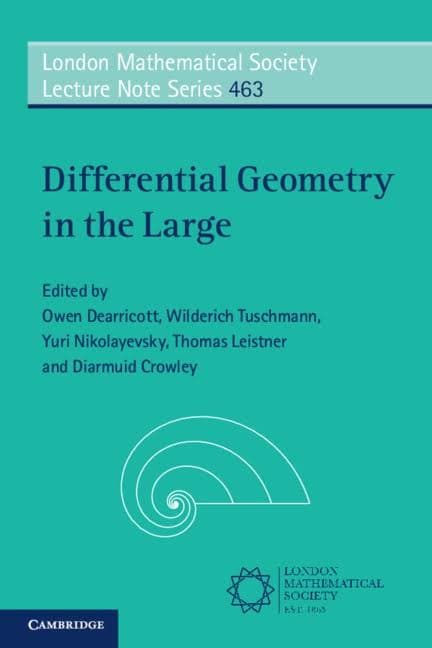All rights reserved.
In February 2019, an Australian–German workshop took place at the Mathematical Research Institute (MATRIX) in Creswick, Australia. The first week of the workshop, i.e., from 4 to 8 February, was an international conference with speakers from many countries. In the second week, from 11 to 15 February, the workshop was organized in three more specialized sessions, following the main topics “Geometric evolution equations and curvature flow,” “Structures on manifolds and mathematical physics,” and “Recent developments in non-negative sectional curvature.”
The book under review is a collection of 17 contributions by speakers at this conference, grouped into the three main themes listed above. All parts were peer-reviewed. The intention of most of the contributions is to give an overview of new developments in the field. All contributions can be read independently, thus every reader is invited to choose those articles that best fit their interests; and this is what I will do as well in this review. My choice is based purely on my personal interests and experience, and no statement about the quality of the contributions is made.
Claude LeBrun’s contribution starts with a nicely written introduction to one of his favourite subjects, namely, Einstein metrics on closed -dimensional manifolds. The article focusses on del Pezzo surfaces, which amounts to considering the cases and , . It is already known that these manifolds carry Einstein metrics, but the associated moduli space is not fully determined: known Einstein metrics all satisfy for a non-zero self-dual harmonic -form , however it remains open whether further ones exist. The article excludes new types of Einstein metrics, namely those with where the zero set of is generic. Overall a pleasure to read.
Other articles summarize existing results in a nice way. This is, for example, the case for the contribution by Kröncke and Vertman, in which they review their progress about the Ricci flow on manifolds with conical singularities. This subject is interesting, as Ricci flows often run into singularities; traditionally one uses surgeries and one restarts the flow, but in view of some applications, e.g., in order to study moduli spaces of Riemannian metrics with some curvature properties, one would prefer that Ricci flows even survive the formation of such singularities in some weak sense, and then continue as Ricci flows with conical singularities.
The contribution by Ludewig summarizes joint work with Güneysu and Hanisch in which they construct rigorously a supersymmetric path integral. This article is motivated by mathematically very interesting and stimulating questions in quantum mechanics and statistical physics.
The chapter written by Gover and Waldron discusses a variant of the Yamabe equation, however the scaling function arises in a non-standard way. For a fixed conformal class on a -dimensional manifold one seeks metrics of scalar curvature . This leads to a partial differential equation for . As long as is positive or negative, this defines a metric . But the article also allows to become zero, and then the metric develops an “end at infinity” at . For example, on the round sphere there is a solution vanishing on the equatorial sphere such that is isometric to two copies of -dimensional hyperbolic space. One interesting aspect of the article was for me that the zero set of satisfies nice conformally invariant equations, e.g., for it is a stationary point of the Willmore energy, a so-called Willmore surface.
There are many more interesting contributions by renowned experts. I cannot comment on all of them, but let us also have a glance at the contribution by Stephan Klaus. I guess that many readers of the EMS Magazine have met him at a conference in Oberwolfach, Germany, without knowing his field of interest. Stephan Klaus is one of the key figures in this institute, and he contributes essentially to its smooth operation and effective organization. But he is also a strong mathematician, as you can see from his contribution about the simplicial Gauss–Bonnet–Chern theorem, the famous generalization of the Gauss–Bonnet theorem for closed surfaces. If you want to know about his research, his article gives great insight.
To sum-up, this collection of articles gives nice and self-contained introductions to the working fields of the authors. The reader should have a solid knowledge of Riemannian geometry, but more specialized expert knowledge is provided in the contributions. Some contributions also include interesting open problems. The book will be of interest for experts wishing to learn about recent developments, but also for young mathematicians who want to get an overview of current developments in the field.
O. Dearricott, W. Tuschmann, Y. Nikolayevsky, T. Leistner and D. Crowley (eds.), Differential Geometry in the Large. London Mathematical Society Lecture Note Series 463, Cambridge University Press, 2020, 398 pages, Paperback ISBN 978-1-108-81281-8, eBook ISBN 978-1-108-88413-6.
Cite this article
Bernd Ammann, Book review: “Differential Geometry in the Large” by O. Dearricott, W. Tuschmann, Y. Nikolayevsky, T. Leistner and D. Crowley (eds.). Eur. Math. Soc. Mag. 132 (2024), pp. 66–67
DOI 10.4171/MAG/195
